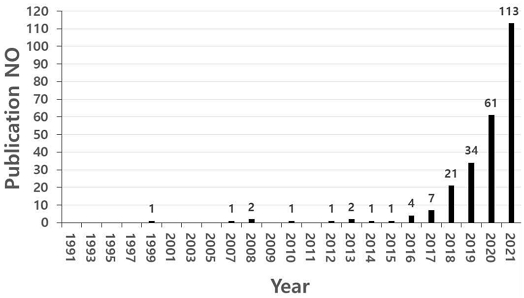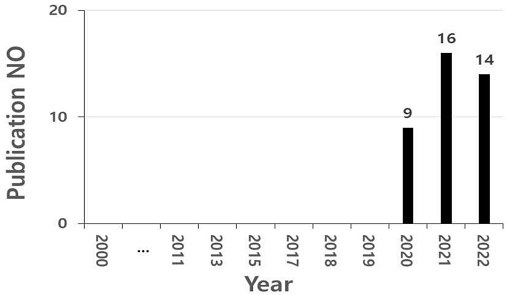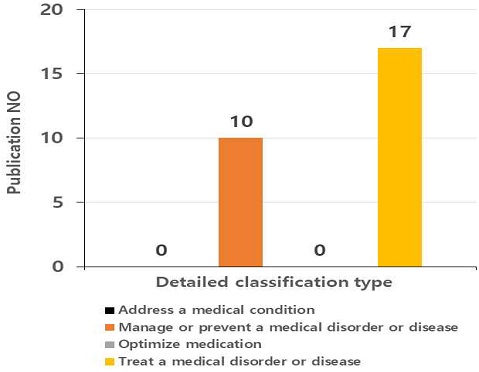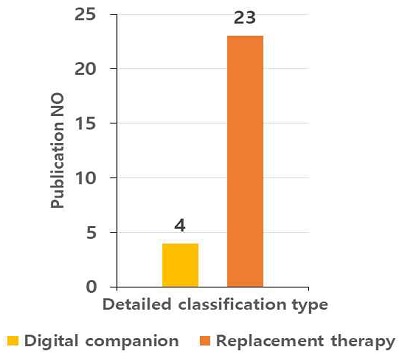
디지털 치료제에 관한 연구: 제품 사례 분석과 제언
Copyright ⓒ 2023 The Digital Contents Society
This is an Open Access article distributed under the terms of the Creative Commons Attribution Non-CommercialLicense(http://creativecommons.org/licenses/by-nc/3.0/) which permits unrestricted non-commercial use, distribution, and reproduction in any medium, provided the original work is properly cited.

초록
최근 COVID-19의 장기화 및 소프트웨어 시장의 발전으로 인해, 해외 디지털 치료제의 제품 사례가 증가하고 있다. 이에 따라 국내에서도 디지털 치료제의 제품 사례가 증가하는 추세이다. 그러나 국내 디지털 치료제 제품 사례들을 분류하여, 디지털 치료제 개발 경향 및 추세를 확인한 연구는 미비한 실정이며, 이에 대한 연구가 필요하다. 따라서 본 논문에서는 국내 디지털 치료제 제품 사례들을 분류하고, 이를 통해 디지털 치료제가 나아가야 할 방향을 제언하였다. 연구 방법은 다음과 같은 절차를 통하여 수행되었다. 1) 기존 디지털 치료제 관련 선행 연구들을 기반으로 디지털 치료제의 정의 및 분류 기준을 정리하였다. 2) 정리한 결과를 기반으로 국내 디지털 치료제 제품 사례들을 분류하여 추세를 확인하였다. 3) 향후 디지털 치료제의 발전 및 개선 방향을 제언하였다.
Abstract
Recently, due to the prolongation of COVID-19 and the development of the software market, the number of products of overseas digital therapeutics is increasing, and the number of products of digital therapeutics is increasing in Korea. However, there is a lack of research on trends and trends in the development of digital therapeutic products by classifying domestic digital therapeutics product cases, and further research is needed. In this paper, we classify the cases of domestic digital therapeutic products and propose directions for digital therapeutics products. 1) The definition and classification criteria of digital therapeutics were summarized based on previous studies related to existing digital therapeutics. 2) Based on the summarized results, the trend was confirmed by classifying domestic digital therapeutics product cases. 3) In the future, the development and improvement directions of digital therapeutics were suggested.
Keywords:
Digital Therapeutics, Digital Therapeutics definition, Digital Therapeutics type, Digital Therapeutics products case, Digital Therapeutics trends키워드:
디지털 치료제, 디지털 치료제 정의, 디지털 치료제 유형, 디지털 치료제 제품 사례, 디지털 치료제 동향Ⅰ. 서 론
기존의 전통적인 치료제는 천연물, 화학 물질, 생물체 중 한가지로 만들어진 의약품을 의미한다[1]. 알약이나 캡슐 등의 경구용 치료제로 처방되는 1세대 치료제(저분자 화합물로 제작)와 주사제로 처방되는 2세대 치료제(항체, 단백질, 세포 등의 생물제제로 제작)가 전통적인 치료제의 대표적인 예이다[2]. 이러한 전통적인 치료제는 독성 및 부작용의 가능성이 있으며, 제작비용과 구매 비용을 추정하기 어렵고, 그 외에도 복약관리 불가, 환자 데이터 수집·관리·저장에 어렵다는 한계가 있었다[3]. 따라서 이러한 한계점을 극복하기 위해 디지털 기술에 기반을 둔 디지털 치료제가 3세대 치료제로 주목받기 시작했다[4-7]. 이러한 디지털 치료제의 시장 및 관련 연구는 2017년 해외의 Pear Therapeutics社의 reset-O가 FDA 승인을 받은 것을 기점으로 급격하게 성장하였다[6]. 특히 COVID-19로 인해 비대면 의료 체계가 활성화됨에 따라 디지털 치료제 또한 각광받아 시장 규모가 증가했다[8].
해외 디지털 치료제의 세계 시장의 규모는 2016년 기준, 16억 달러에서 2025년 기준, 89억 달러 규모까지 성장할 것으로 전망된다(연평균 20.5%의 성장률 예상)[9]. 이러한 디지털 치료제 시장의 세계적인 성장세에 따라 국내 디지털 치료제 시장도 2020년 기준, 4,742만 달러 시장 규모에서 2027년 기준, 2억 437만 달러까지 성장할 것으로 전망된다(연평균 23.2%의 성장률 예상)[10].
위와 같이 디지털 치료제 분야의 성장 추세에 따라 국내 디지털 치료제의 사용 사례도 급격하게 증가하고 있다. 그러나 국내 디지털 치료제 제품 사례들을 심도 있게 분류하여, 제품 사례의 경향 및 추세를 확인할 수 있는 연구는 미비한 실정이며, 이에 대한 연구가 추가로 필요하다.
따라서 본 논문에서는 국내 디지털 치료제의 제품 사례들을 분석하고, 이를 통해 디지털 치료제가 나아가야 할 방향을 제언하고자 한다. 본 논문의 구성은 다음과 같다. 제2장에서는 디지털 치료제의 선행 연구들을 기반으로 디지털 치료제의 정의 및 분류 기준을 정리하였다. 제3장에서는 제2장에서 정리한 결과를 바탕으로 도출된 분류 기준들을 통해 국내 디지털 치료제 제품 사례들을 분류하였다. 마지막으로, 향후 국내 디지털 치료제의 발전 방향을 제언하였다. 본 논문은 그 동안 미비하였던 실제 국내 디지털 치료제 제품 사례들을 대상으로 분석이 수행되므로 기존의 타 연구들과의 차별성이 있다.
Ⅱ. 관련 연구
2-1 국내 디지털 치료제 선행 연구 추세
[6]에 따르면, 해외 디지털 치료제 문헌 수는 2017년 관련 문헌 7편에서 21편으로 3배가량 급격히 증가하였다.
그림 1은 [6]에서 확인한 해외 디지털 치료제 문헌 수의 증가추세에 본 논문에서 2020년, 2021년의 문헌 수를 추가한 모습을 나타낸다. 2020년, 2021년의 문헌 수집 절차는 [6]의 문헌 수집 절차와 동일하게 수행하였다. 이러한 해외 연구 동향에 따라, 증가하고 있는 국내의 디지털 치료제 관련 연구 동향의 정확한 동향을 확인하고자, 다음과 같이 [6]의 문헌 수집 절차를 참고하여 문헌을 수집하였다. 첫째, 기간은 2000년도 이후로 설정하였다. 문헌 종류는 논문, 학술 논문, 학위 논문으로 제한하였다. 둘째, 학술연구정보서비스 RISS, 학술연구정보서비스 DBPia, 한국학술지인용색인 KCI를 이용하여 관련 문헌을 추출하였으며, 추출 중 중복되는 문헌은 제외하였다. 또한 문헌의 주 제안점이 디지털 치료제와 연관이 없으면 제외하였다. 셋째, 키워드는 ‘디지털 치료제’ 뿐만 아니라 같은 의미로 사용되는 ‘디지털 테라퓨틱스(Digital Therapeutics)’를 포함하였다. 문헌 수집 결과, 2022년 9월 7일 기준 39편의 문헌이 수집되었으며, 결과는 그림 2와 같다. 그림 2에 나타낸 바와 같이, 국내 디지털 치료제 문헌 수는 2019년 관련 문헌 수 0편에서 2022년 9월 7일 기준, 14편으로 증가함을 확인하였다. 그림 2의 2022년 문헌 수가 2021년 문헌 수보다 적은 이유는 2022년 9월까지의 수집 결과이기 때문이다.
2-2 디지털 치료제 정의
‘디지털 치료제’는 영어로 ‘Digital Therapeutics(DTx)’라고 하며, 이는 한국어로 정식 번역된 용어는 아니다[11]. 다만, 디지털 치료제라는 용어는 이미 국내 업계에서 통용되고 있는 용어이며, 국가에서 정의하고 있는 용어는 ‘디지털 치료기기’이다[12]. 디지털 치료제의 전신이 되는 개념은 2015년에 등장하였다[13, 14]. [13]에 따르면, 디지털 헬스(Digital Health)를 세분화하면서 도출된 개념인 디지털 치료제를 “의료의 접근성과 효율성을 높일 수 있는 온라인으로 전달되는 증거 기반 행동 치료”로 정의하였다. [14]에 따르면, “Digital Medicine”이라는 용어를 제시하면서 이를 “질병 등의 상태를 진단, 예방, 모니터링 또는 치료에 직접적인 영향을 미칠 수 있는 임상 검증을 거친 기술 제품”으로 정의하였다.
현재까지 디지털 치료제의 정의는 여러 연구기관에서 의해 다양하게 정의되고 있다. 해외 비영리협회인 디지털 치료제 협회(DTA; Digital Therapeutics Alliance)는 디지털 치료제를 “질병을 예방·관리·치료하기 위해 환자에게 소프트웨어를 통해 근거 기반 치료제를 개입하는 것(evidence-based therapeutics interventions)”으로 정의하였다[15]. 또한 [16]에 따르면, ‘디지털 또는 온라인 기술을 활용하는 치료 목적 훈련 또는 치료 옵션’으로 정의하였다. [17]에 따르면, “질병의 예방, 치료, 예후 관리 등을 목적으로 개발된 소프트웨어 형태”로 정의하였다. 국내의 경우, 식품의약품안전처는 디지털 치료제를 “질병이나 장애를 예방, 관리, 치료하기 위해 환자에게 근거 기반의 치료적 중재(evidence-based therapeutics intervention)를 제공하는 고도화된 소프트웨어 의료기기”로 정의하였다[12]. 또한 [18]에 따르면, “약물은 아니지만, 의약품과 같이 질병을 치료하고 건강을 향상시킬 수 있는 소프트웨어”로 정의하였다.
이러한 디지털 치료제 정의들의 공통적인 부분들을 통합하여 정리하면, 디지털 치료제는 “디지털에 기반하여, 여러 가지 기존 치료 방법들과 병행하거나 기존 치료 방법을 보조해주는 치료제”라고 정의할 수 있다.
2-3 디지털 치료제의 유형
디지털 치료제의 유형은 사용 목적에 따른 유형, 치료 행위에 따른 유형, 그리고 치료 방식에 따른 유형으로 분류된다.
DTA는 디지털 치료제의 유형을 표 1과 같이 사용 목적에 따라 건강 상태 관리 유형, 의학적 장애·질병의 관리 및 예방용 유형, 복약 최적화용 유형, 의학적 장애·질병의 치료용 유형으로 분류하였다[19].
건강 상태 관리 유형은 사용 기관의 재량에 따라 효능을 검증하며, 환자가 직접 구매할 수 있고 의사의 처방이 필요 없는 유형이다.
이 유형은 의료적 효능을 주장하지 않기 때문에 다른 유형에 비해 국가 기관의 승인이 필요 없고, 처방이 불필요하다.
의학적 장애·질병의 관리 및 예방 유형은 국가기관으로부터 효능에 대한 승인과 의사의 처방이 필요하다. 이 유형은 경도~중도 사이의 장애·질병 관련 효능을 주장할 수 있으며, 예시로 질병 진행 속도를 늦추는 디지털 치료제가 포함된다.
복약 최적화 유형은 국가기관으로부터 효능에 대한 승인과 의사의 처방이 필요하다. 이 유형은 중도~고도 사이의 장애·질병 관련 효능을 주장할 수 있으며, 예시로 기존 치료제와 같이 쓰임으로써 치료 효과를 증가시키는 디지털 치료제가 포함된다.
의학적 장애·질병의 치료 유형은 국가기관으로부터 효능에 대한 승인과 의사의 처방이 필요하다. 이 유형은 중도~고도 사이의 장애·질병 관련 효능을 주장할 수 있으며, 예시로 임상 결과에 대한 직접적인 효능을 주장할 수 있는 디지털 치료제가 포함된다.
디지털 치료제는 치료 행위에 대한 독립성 여부를 기준으로 표 2와 같이 2가지 유형으로 분류된다[20]. 보완 디지털 치료제 유형은 기존 치료제를 보조하여 효능 향상을 목적으로 한다. 즉, 보완 디지털 치료제 유형은 단독 사용이 불가하고 반드시 기존 치료제와 함께 사용한다.
대체 디지털 치료제 유형은 디지털 기술 자체만으로 치료 · 예방의 효과를 내는 것을 목적으로 한다. 대체 디지털 치료제 유형은 기존 치료제를 대체하여 단독 사용할 수 있으며, 기존 치료제와 병용하여 치료 효과를 증가시킬 수 있다.
디지털 치료제는 치료 방식에 따라 표 3과 같이 3가지로 분류된다[6]. 생활 습관 교정 및 복약관리 디지털 치료제 유형은 환자 개인별로 소프트웨어를 통해 지속적인 모니터링을 하여 식단, 약 복용량 등을 맞춤 제공함으로써, 생활 습관을 교정하는 디지털 치료제이다. 신경 재활 디지털 치료제 유형은 신경을 자극하여 신경을 활성화하는 방식의 디지털 치료제이다. 인지행동 디지털 치료제 유형은 문제가 되는 행동을 변화시키는 것에 초점을 맞춘 디지털 치료제이다.
Ⅲ. 국내 디지털 치료제 제품 사례분석
3-1 국내 디지털 치료제 제품 사례 조사
국내 디지털 치료제의 제품 사례를 확인하기 위해 국내 디지털 치료제의 제품 사례들을 조사하였다. 조사한 제품 사례들은 선행 연구의 자료를 토대로 재구성하였다[21, 22]. 그 결과는 표 4와 같다. 표 4는 국내 디지털 치료제 제품 사례명과 해당 제품 사례의 특징을 정리하였으며, 3-2에서 각 제품 사례를 분류하는 기준으로 활용되었다.
3-2 국내 디지털 치료제 제품 사례의 분류
본 절에서는 1절에서 조사된 국내 디지털 치료제 제품 사례의 경향 및 추세를 알아보기 위해 국내 디지털 치료제 제품 사례들을 분류한다. 이를 위해 먼저 디지털 치료제 제품 사례의 분류 기준을 제안한다. 제안하는 분류 기준은 표 5와 같다.
제안하는 분류 기준은 2장 2절에서 도출된 3가지 유형들에 사용 장치 형태에 따른 유형을 추가한 4가지이다. 선행 연구들에서 가장 대표적으로 언급되는 디지털 치료제의 형태들은 크게 모바일 장치 기반 유형, 데스크탑 장치 기반 유형, 웨어러블 장치(Head-Mounted-Display : HMD와 같은 착용형 장치 포함) 기반 유형으로 분류할 수 있다. 이에 따라 넷째 유형인 사용 장치 형태에 따른 유형을 추가로 제시한다.
첫째 ~ 셋째 분류 기준을 기반으로 수행한 분류의 목적은 국내 디지털 치료제 제품 사례들이 선행 연구들을 통해 도출된 유형들을 기준으로 어떤 경향 및 추세를 띄는지 확인하고자 수행하였다. 넷째 분류 기준을 기반으로 수행한 분류의 목적은 국내 디지털 치료제 제품 사례들이 어떤 장치를 기준으로 어떤 경향 및 추세를 띄는지 확인하고자 수행하였다.
첫째 기준의 상세 분류 유형으로는 건강 상태 관리 유형, 의학적 장애·질병의 관리 및 예방 유형, 복약 최적화 유형, 의학적 장애·질병의 치료 유형이 있다.
둘째 기준의 상세 분류 유형으로는 보완 디지털 치료제 유형, 대체 디지털 치료제 유형이 있다.
셋째 기준의 상세 분류 유형으로는 생활 습관 교정 및 복약관리 디지털 치료제 유형, 신경 재활 디지털 치료제 유형, 인지행동 유형이 있다.
넷째 기준의 상세 분류 유형으로는 모바일 장치 기반 유형, 데스크탑 장치 기반 유형, 웨어러블 장치 기반 유형이 있다.
도출된 유형들을 기반으로 3장 1절에서 조사된 디지털 치료제 제품 사례들을 분류하였다(표 6 참조). 제품 사례 중에서 현재 상세 정보가 공개되지 않은 사례는 분류에서 제외하였다(두브레인[28]). 첫째, 국내 디지털 치료제 제품 사례들을 사용 목적에 따른 유형을 기반으로 분류한 결과는 표 6과 같다. 분류 결과, 건강 상태 관리 유형과 복약 최적화 유형을 위한 디지털 치료제 개발 현황은 미비하였으며, 의학적 장애·질병의 치료 유형이 가장 높은 비중을 차지하는 경향이 나타났으며, 그림 3과 같다. 둘째, 국내 디지털 치료제 제품 사례들을 치료 행위에 따른 유형을 기반으로 분류한 결과는 표 7과 같다. 분류 결과, 대체 디지털 치료제 유형이 보완 디지털 치료제 유형보다 비중을 차지하는 경향이 나타났으며, 그림 4와 같다. 셋째, 국내 디지털 치료제 제품 사례들을 치료 방식에 따른 유형을 기반으로 분류한 결과는 표 8과 같다. 분류 결과, 전체적으로 고르게 분포하고 있는 경향이 나타났으며, 그림 5와 같다. 넷째, 국내 디지털 치료제 제품 사례들을 사용 장치 형태에 따른 유형을 기반으로 분류한 결과는 표 9와 같다. 단, 모바일 장치 기반 유형과 데스크탑 장치 기반 유형 모두 실행이 가능한 사례들은 중복으로 분류하였다([219-31], [45], [47-48]). 분류 결과, 모바일 장치 기반 유형이 가장 많은 비중을 차지하는 경향이 나타났으며, 그림 6과 같다.
Ⅳ. 결론 및 제언
해외 디지털 치료제 분야의 성장 추세에 따라 국내 디지털 치료제의 사용 사례도 급격하게 증가하고 있다. 그러나 국내 디지털 치료제 제품 사례들을 심도 있게 분류하여, 제품 사례의 경향 및 추세를 확인할 수 있는 연구는 미비한 실정이며, 이에 대한 연구가 추가로 필요하다. 따라서 본 논문에서는 기존 디지털 치료제 관련 선행 연구들을 기반으로 디지털 치료제의 정의 및 분류 기준을 정리하였다. 그리고, 정리한 결과를 기반으로 국내 디지털 치료제 제품 사례들이 여러 가지 분류 기준에 의해 나타나는 경향을 알아보았다.
국내 디지털 치료제 제품 사례들을 분류하기 위해, 제안한 디지털 치료제 분류 기준은 다음과 같다.
첫째, 사용 목적에 따른 유형이다. 상세 분류 유형으로는 건강 상태 관리 유형, 의학적 장애·질병의 관리 및 예방 유형, 복약 최적화 유형, 의학적 장애·질병의 치료 유형이 있다. 둘째, 치료 행위에 따른 유형이다. 상세 분류 유형으로는 보완 디지털 치료제 유형, 대체 디지털 치료제 유형이 있다. 셋째, 치료 방식에 따른 유형이 있다. 상세 분류 유형으로는 생활 습관 교정 및 복약관리 디지털 치료제 유형, 신경 재활 디지털 치료제 유형, 인지행동 유형이다. 넷째, 사용 장치 형태에 따른 유형이다. 상세 분류 유형으로는 모바일 장치 기반 유형, 데스크탑 장치 기반 유형, 웨어러블 장치 기반 유형이 있다.
이를 기반으로 국내 디지털 치료제 제품 사례들을 분류한 결과와 이에 대한 제언점은 다음과 같다.
첫째, 사용 목적에 따른 유형 기준으로, 국내 디지털 치료제는 의학적 장애·질병의 치료 유형을 지향하면서 개발되어야 한다. 국내 디지털 치료제 제품 사례들을 사용 목적에 따라 분류한 결과, 건강 상태 관리 유형과 복약 최적화 유형을 위한 디지털 치료제 개발 현황은 미비하였으며, 의학적 장애·질병의 치료 유형이 가장 높은 비중을 차지하는 경향이 나타났다. 이는 의학적 장애·질병의 치료 유형을 통해 전통적인 치료제의 대체가 가능하기 때문으로 판단된다.
둘째, 치료 행위에 따른 유형 기준으로, 국내 디지털 치료제는 대체 디지털 치료제 유형을 지향하면서 개발되어야 한다. 국내 디지털 치료제 제품 사례들을 치료 행위에 따라 분류한 결과, 대체 디지털 치료제 유형이 보완 디지털 치료제 유형보다 훨씬 비중을 차지하는 경향이 나타났다. 이는 대체 디지털 치료제 유형을 통해 전통적인 치료제의 대체가 가능하기 때문으로 판단된다.
셋째, 치료 방식에 따른 유형 기준으로, 국내 디지털 치료제는 개발 전, 대상 질병이나 증상을 선정할 시, 자유롭게 선정해도 될 것으로 판단된다. 국내 디지털 치료제 제품 사례들을 치료 방식에 따라 분류한 결과, 전체적으로 고르게 분포하고 있는 경향이 나타났다. 이는 디지털 치료제의 수요가 특정 질병이나 증상에 국한되지 않기 때문으로 판단된다.
넷째, 사용 장치 형태에 따른 유형 기준으로, 국내 디지털 치료제는 모바일 장치 기반 유형을 지향하면서 개발되어야 한다. 국내 디지털 치료제 제품 사례들을 사용 장치 형태에 따라 분류한 결과, 모바일 장치 기반 유형이 가장 많은 비중을 차지하는 경향이 나타났다. 이는 보편적으로 대중화된 모바일 기기를 통해 디지털 치료제 개발이 가능하기 때문으로 판단된다.
본 연구의 목적은 국내 디지털 치료제 제품의 수요, 경향 및 추세를 확인하는 것이다. 따라서 이를 위해 디지털 치료제 선행 연구들을 기반으로 디지털 치료제 분류 방법을 정리하고, 정리한 결과를 포함한 여러 가지 분류 기준을 기반으로 국내 디지털 치료제 제품 사례들을 분류하였다. 이를 통해 국내 디지털 치료제의 제품 사례의 경향 및 추세를 확인하였으며, 향후 후발 개발 업체가 제품 수요를 확인하는 것에 참고가 될 것을 기대한다.
Acknowledgments
본 논문은 2020년도 한국기술교육대학교 교수 교육연구진흥과제 지원에 의하여 연구되었습니다.
References
- S. W. Lee, “Digital Therapeutics and the Future”, Journal of Korean Society of Health-system Pharmacists, Vol. 38, No. 3, pp. 281-290, August 2021.
- S. H. Ahn, Digital Therapeutics Trends, Korea Bio-Economy Research Center, July 2020.
- S. M. Lee, KHIDI Bio Health Report, Korea Health Industry Development Institute, pp. 51-62, January 2019.
- J. H. Park, S. J. Song and M. C. Bae, Digital Therapeutics Technology Trends and Industry Outlook, Korea Evaluation Institute of Industrial Technology, pp. 75-91, March 2020.
- Digital Therapy Issues Report, INNOPLIS(Korea Innovation Foundation), pp. 1-31, October 2021.
- A. S. Park, S. M. Lee, Current Status Analysis and Development Direction of Digital Therapy Products, Electronics and Telecommunications Research(ETRI) Institute(ETRI), 978-89-5519-283-4, pp. 1-63, November 2020.
- Y. J. Kim, Development status of Digital Theraputics Products, Korea Insurance Research Institute(KIRI), pp. 23-25, October 2020.
- J. Y. Kim, In the contactless era, the current status and development direction of contactless medical care at home and abroad, Korea Institute of S&T Evaluation and Planning(KISTEP), pp. 1-34, July 2020.
- J. W. Kim, K. J. Jang, E. H, Hwang, Digital Therapeutics, Korea Institute of S&T Evaluation and Planning(KISTEP), pp. 1-37, December 2020.
- Digital Therapy Market Global Market Trend Report, Korea Innovation Foundation(INNOPLIS), pp. 1-18, May 2021.
- C. Y. Lee, “Digital Therapeutics Using Brain Waves XR Research on How to Create Contents”, The Korean Journal of animation, The Korean Journal of animation, Vol. 16, No. 4, pp. 197-209, December 2020.
- Y. M. Han, Guidelines for Approval and Screening of Digital Therapeutic Devices, Ministry of Food and Drug Safety(MFDS), 1045-01, pp. 1-24, August 2020.
-
Sepah, S. C, Jiang, L, Peters, A. L, “Long-Term Outcomes of a Web-Based Diabetes Prevention Program: 2-Year Results of a Single-Arm Longitudinal Study”, Journal of medical Internet research, Vol. 17, No. 4, April 2015.
[https://doi.org/10.2196/jmir.4052]

-
Elenko E, Underwood L, Zohar D. “Defining digital medicine”, Nat Biotech, Vol. 33, No. 5, pp. 456-461, May 2015.
[https://doi.org/10.1038/nbt.3222]

- Digital Therapeutics Alliance(DTA), Digital Therapeutics: Combining Technology and Evidence-based Medicine to Transform Personalized Patient Care, October 2018.
-
J. Y. Chung, “Digital therapeutics and clinical pharmacology”, Transl Clin Pharmacol, Vol. 27, No. 1, pp. 6-11, March 2019.
[https://doi.org/10.12793/tcp.2019.27.1.6]

-
Sverdlov O, Van Dam J, Hannesdottir K, Thornton-Wells T, “Digital therapeutics: an integral component of digital innovation in drug development”, Clinical Pharmacology & Therapeutics, Vol. 104, No. 1, pp. 72-80, January 2018.
[https://doi.org/10.1002/cpt.1036]

-
S. Y. Kwon, M. S. Kim, C. B. Lee, J. H. Ryu, “A Study on Digital Therapeutics and Their Possibilities on Disease Control”. Regulatory Research on Food, Drug and Cosmetic, Vol. 16, No. 2, pp. 181-192, December 2021.
[https://doi.org/10.23049/FDCRS.2021.16.2.181]

- Digital Therapeutics Alliance(DTA), DTx Product Catergorization, January 2021.
- McKinsey & Company, Digital therapeutics: Preparing for takeoff, February 2018.
- M. R. Kim, J. W. Shin, “Definition and Technology of Digital Therapeutics”, The Magazine of the IEIE, Vol. 49, No. 3, pp. 17-24, March 2022.
- J. H. Wi, A Study on the Application of Game as Digital Therapeutics, Korea Creative Content Agency (KOCCA), KOCCA21-41, pp. 1-305, January 2022.
- Todak's panic care [Internet]. Available: https://play.google.com/store/apps/details?id=com.fnikorea.todaki.panic
- Heart growth program todak todak [Internet]. Available: https://play.google.com/store/apps/details?id=com.mhrnd.tdc
- Circadian rhythm for mood (CRM) [Internet]. Available: https://hucircadian.com/service/crm-circadian-rhythm-for-mood/
- Noom coach [Internet]. Available: https://play.google.com/store/apps/details?id=com.wsl.noom&hl=ko&gl=US
- Nunap vision [Internet]. Available: https://www.nunaps.com/
- Dobrain [Internet]. Available: https://dobrain.co/
- Redpill care [Internet]. Available: https://lifesemantics.kr/service/redpillCare
- Efill careM [Internet]. Available:https://www.lifesemantics.kr/service/efilcareM
- Redpill breath [Internet]. Available:https://lifesemantics.kr/service/redpillBreath
- Super brain [Internet]. Available:https://play.google.com/store/apps/details?id=com.rowan.superbrain&hl=en_US&gl=US
- Cheerful non-smoking school [Internet]. Available: http://www.fnikorea.com/product_noSmoking.html
- Behave care [Internet]. Available: http://www.fnikorea.com/product_behavcare.html
- Panic-Relieve [Internet]. Available: http://www.fnikorea.com/product_panicRelieve.html
- ADHD-Pay Attention [Internet]. Available: http://www.fnikorea.com/product_adhd.html
- Minds care [Internet]. Available: https://medimind.kr/product_mindscare.html
- Seni-en care [Internet]. Available: http://www.fnikorea.com/product_seniencare.html
- NUROW (AIMDT–01) [Internet]. Available: https://www.aimmed.co.kr/innovation/dtx_pipelines#sc_aimDT01
- Somzz (AIMDT-02) [Internet]. Available: https://www.aimmed.co.kr/innovation/dtx_pipelines#sc_aimDT02
- SAT-001 [Internet]. Available: https://www.salphadtx.com/pipelines
- AGAIN [Internet]. Available: https://www.weltcorp.com/%EB%B3%B5%EC%A0%9C-about-us
- WELT-I [Internet]. Available: https://www.hankyung.com/it/article/202202040333i
- WELT-A [Internet]. Available: http://www.biospectator.com/view/news_view.php?varAtcId=11434
- AnzeiLax [Internet]. Available: http://kr.acrofan.com/detail.php?number=245023
- Y. Y. Kang, H. J. Cho, B. R. Kim, J. H. Kim, J. H. Yoon, J. Y. Lee, S. J. Hong, K. H. Kim, J. W. Kim, “Alzguard: Conversational Digital Therapeutics for Mild Cognitive Impaired Care”, Proceedings of HICK 2020, Daemyung Resort Vivaldi Park, pp. 1-5, February 2020.
- ForMe [Internet]. Available: https://www.haii.co.kr/#product
- PATAKA [Internet]. Available:https://www.haii.co.kr/#product
- SaeMi [Internet]. Available: https://saemi.haii.co.kr/
- My health note [Internet]. Available:https://www.huray.net/archives/portfolio/%EB%A7%88%EC%9D%B4%ED%97%AC%EC%8A%A4%EB%85%B8%ED%8A%B8
저자소개

2020년 : 한국기술교육대학교 컴퓨터공학부 (공학사)
2020년~현 재 : 한국기술교육대학교 대학원 컴퓨터공학과 (공학석사)
※관심분야: 게임콘텐츠(Game Contents), 가상현실(Virtual Reality), 증강현실(Augmented Reality)

1993년 : 성균관대학교 전기공학과 (공학사)
1995년 : 성균관대학교 대학원 전기공학과 (공학석사)
1999년 : 성균관대학교 대학원 전기공학과 (공학박사)
1999년~2000년: 한국과학기술연구원 Post-Doc.
2000년~2003년: Univ. Washington 전기공학과 Faculty Research Associate
2003년~2005년: 삼성종합기술원 수석연구원
2005년~현 재: 한국기술교육대학교 컴퓨터공학부 교수
※관심분야:가상 시뮬레이션(Virtual simulation), 전력-IT 기술(Power-IT technology), 바이오 인포매틱스(Bio-informatics) 등






